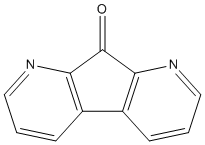All AbMole products are for research use only, cannot be used for human consumption.

DFO (1,8-Diazafluoren-9-one) is a fluorescent dye forming highly fluorescent derivatives with amino acids (excitation ~470 nm; emission ~570 nm). Used for the detection of latent fingerprints on paper with high sensitivity. 1,8-diazafluoren-9-one (DFO) are used in the forensic field to enhance latent fingerprints deposited on porous surfaces due to the formation of fluorescent products by reacting with the amino acids present in the papillary exudate. DFO has been the most used because of its excellent enhancing properties, even if it is more expensive and relatively toxic in comparison with the 1,2-IND.

Adv Sci (Weinh). 2023 Mar 27;e2207224.
Hypoxia Drives Material‐Induced Heterotopic Bone Formation by Enhancing Osteoclastogenesis via M2/Lipid‐Loaded Macrophage Axis
DFO purchased from AbMole

Oxid Med Cell Longev. 2023 Jan 14;2023:6896790.
Curcumin Induces Ferroptosis in Follicular Thyroid Cancer by Upregulating HO-1 Expression
DFO purchased from AbMole
| Molecular Weight | 182.18 |
| Formula | C11H6N2O |
| CAS Number | 54078-29-4 |
| Solubility (25°C) | DMSO 30 mg/mL acetic acid 10 mg/mL |
| Storage | 2-8°C, protect from light |
| Related Fluorescent Dye Products |
|---|
| Copper probe CF4
Copper probe CF4 (Copper fluor CF4) is a Cu+-specific fluorescent probe based on a rhodol dye scaffold. Copper probe CF4 (Copper fluor CF4) has high copper selectivity with a Kd value of 2.9×10-13 M, particularly over zinc and iron, as well as abundant cellular alkali and alkaline earth metals. Copper probe CF4 (Copper fluor CF4) is stable in a physiologically relevant pH regime between 6 and 8 (wavelengths of 415 nm for excitation and 660 nm for emission). Copper probe CF4 (Copper fluor CF4) can be used to study colon cancer. |
| Phalloidin-Fluor 647 Conjugate
Phalloidin-Fluor 647 Conjugate selectively binds to F-actins. Used at nanomolar concentrations, phalloidin derivatives are convenient probes for labeling, identifying and quantitating F-actins in formaldehyde-fixed and permeabilized tissue sections, cell cultures or cell-free experiments. |
| HBC530
HBC530 is a GFP fluorophore-like synthetic dye, with a structurally rigid electron acceptor and a strong electron donor. HBC is nonfluorescent in solution, and when combined with Pepper (RNA aptamer), HBC forms a tight complex and activates and emits bright fluorescence (Kd of ~3.5 nM). HBC emission peaks vary in different complexes and covers the spectrum from cyan to red. HBC can be used in the live cell imaging of RNA (Em/Ex = 530/485 nm). |
| 2',7'-dichlorodihydrofluorescein
2,7-Dichlorodihydrofluorescein (DCFH2) is a non-fluorescent reactive oxygen species (ROS) probe with an excitation wavelength of 485-500 nm and an emission wavelength of 515-530 nm. 2,7-Dichlorodihydrofluorescein is first hydrolyzed by intracellular esterases and then oxidized by ROS to generate non-biomembrane-permeable, highly fluorescent 2,7-dichlorofluorescein (DCF). 2,7-Dichlorodihydrofluorescein can undergo oxidation reactions with a variety of ROS (such as ·OH, H2O2, ONOO-, etc.) and is used to quantitatively detect the level of oxidative stress inside and outside cells. The fluorescence intensity of DCF is positively correlated with the ROS concentration. |
| 4-MUNANA
4-MUNANA is a substrate of influenza virus neuraminidase (NA) with high selectivity and irreversible reaction. In the enzymatic reaction, 4-MUNANA is hydrolyzed by NA to generate fluorescent 4-methylumbelliferone (4-MU). By detecting the fluorescence intensity of 4-MU, quantitative analysis of NA activity can be achieved. |
All AbMole products are for research use only, cannot be used for human consumption or veterinary use. We do not provide products or services to individuals. Please comply with the intended use and do not use AbMole products for any other purpose.


Products are for research use only. Not for human use. We do not sell to patients.
© Copyright 2010-2024 AbMole BioScience. All Rights Reserved.
